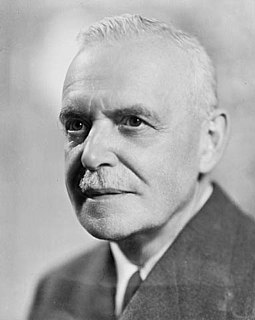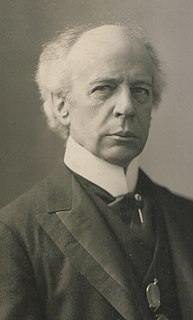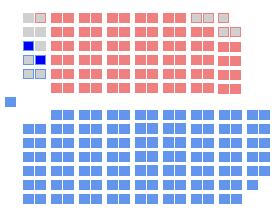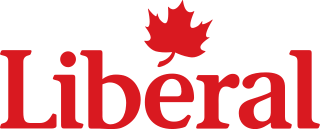
The 38th Canadian Parliament was in session from October 4, 2004 until November 29, 2005. The membership was set by the 2004 federal election on June 28, 2004, and it changed only somewhat due to resignations and by-elections, but due to the seat distribution, those few changes significantly affected the distribution of power. It was dissolved prior to the 2006 election.

The Canadian federal election of 1921 was held on December 6, 1921, to elect members of the House of Commons of Canada of the 14th Parliament of Canada. The Union government that had governed Canada through the First World War was defeated, and replaced by a Liberal government under the young leader William Lyon Mackenzie King. A new third party, the Progressive Party, won the second most seats in the election.

The Canadian federal election of 1867, held from August 7 to September 20, was the first election for the new nation of Canada. It was held to elect members to the House of Commons of Canada, representing electoral districts in the provinces of Nova Scotia, New Brunswick, Ontario and Quebec in the 1st Parliament of Canada. The provinces of Manitoba (1870) and British Columbia (1871) were created during the term of the 1st Parliament of Canada and were not part of the Canadian federal election of 1867.

The Canadian federal election of 1896 was held on June 23, 1896, to elect members of the House of Commons of Canada of the 8th Parliament of Canada. Though the Conservative Party won a plurality of the popular vote, the Liberal Party, led by Wilfrid Laurier, won the majority of seats to form the next government.

The Canadian federal election of 1872 was held from July 20 to October 12, 1872, to elect members of the House of Commons of Canada of the 2nd Parliament of Canada. Prime Minister Sir John A. Macdonald's Conservative Party remained in power, defeating the Liberals. However, the Liberals increased their parliamentary representation considerably, while the Conservative seat count remained static, giving them only five more seats than the Liberals. This technically resulted in the country's first minority government, though the support of two independent Conservative MPs functionally gave Macdonald an extremely slim majority.

The Canadian federal election of 1891 was held on March 5 to elect members of the House of Commons of Canada of the 7th Parliament of Canada. It was won by the Conservative Party of Prime Minister Sir John A. Macdonald.

The Canadian federal election of 1925 was held on October 29 to elect members of the House of Commons of Canada of the 15th Parliament of Canada. Prime Minister William Lyon Mackenzie King's Liberal Party formed a minority government. This precipitated the "King–Byng Affair".

The Canadian federal election of 1874 was held on January 22, 1874, to elect members of the House of Commons of Canada of the 3rd Parliament of Canada. Sir John A. Macdonald, who had recently been forced out of office as prime minister, and his Conservatives were defeated by the Liberal Party under their new leader Prime Minister Alexander Mackenzie.

The Canadian federal election of 1953 was held on August 10 to elect members of the House of Commons of Canada of the 22nd Parliament of Canada. Prime Minister Louis St. Laurent led his Liberal Party of Canada to its fifth consecutive majority government, although the party lost seats to the other parties.

The 1917 Canadian federal election was held on December 17, 1917, to elect members of the House of Commons of Canada of the 13th Parliament of Canada. Described by historian Michael Bliss as the "most bitter election in Canadian history", it was fought mainly over the issue of conscription. The election resulted in Prime Minister Sir Robert Borden's Unionist government elected with a strong majority and the largest percentage of the popular vote for any party in Canadian history.
Donald H. Bell is a Canadian politician. He is currently serving as a councillor for the City of North Vancouver. He previously represented the riding of North Vancouver as Member of Parliament in the House of Commons of Canada from 2004 to 2008 as a member of the Liberal Party of Canada. Before being elected, he was the mayor of the District of North Vancouver.

The Canadian federal election of 1926 was held on September 14 to elect members of the House of Commons of Canada of the 16th Parliament of Canada. The election was called following an event known as the King–Byng affair. In the 1925 federal election, Prime Minister William Lyon Mackenzie King's Liberal Party of Canada won fewer seats in the House of Commons of Canada than the Conservatives of Arthur Meighen. Mackenzie King, however, was determined to continue to govern with the support of the Progressive Party. The combined Liberal and Progressive caucuses gave Mackenzie King a plurality of seats in the House of Commons, and the ability to form a minority government.
The agreement collapsed, however, following a scandal, and Mackenzie King approached the Governor-General, Baron Byng of Vimy, to seek dissolution of the Parliament. Byng refused on the basis that the Conservatives had won the largest number of seats in the prior election, and called upon Meighen to form a government.

The Canadian federal election of 1908 was held on October 26 to elect members of the House of Commons of Canada of the 11th Parliament of Canada. Prime Minister Sir Wilfrid Laurier's Liberal Party of Canada was re-elected for a fourth consecutive term in government with a majority government. The Liberals lost four seats and a small share of the popular vote.

The Canadian federal election of 1904 was held on November 3 to elect members of the House of Commons of Canada of the 10th Parliament of Canada. Prime Minister Sir Wilfrid Laurier led the Liberal Party of Canada to a third term in government, with an increased majority, and over half of the popular vote.

The Canadian federal election of 1900 was held on November 7 to elect members of the House of Commons of Canada of the 9th Parliament of Canada. As a result of the election, the Liberal Party, led by Prime Minister Wilfrid Laurier, was re-elected to a second majority government, defeating the Conservative Party and Liberal-Conservatives led by Charles Tupper.

The Canadian federal election of 1878 was held on September 17 to elect members of the House of Commons of Canada of the 4th Parliament of Canada. It resulted in the end of Prime Minister Alexander Mackenzie's Liberal government after only one term in office. Canada suffered an economic depression during Mackenzie's term, and his party was punished by the voters for it. The Liberals' policy of free trade also hurt their support with the business establishment in Toronto and Montreal.

The Canadian federal election of 1882 was held on June 20, 1882, to elect members of the House of Commons of Canada of the 5th Parliament of Canada.

The British Columbia general election of 1903 was the tenth general election for the Province of British Columbia, Canada. It was held to elect members of the Legislative Assembly of British Columbia. The election was called on September 5, 1903, and held on October 3, 1903. The new legislature met for the first time on November 26, 1903.

This article is the Electoral history of Sir Charles Tupper, the sixthth Prime Minister of Canada. A Conservative, he became prime minister upon the resignation of Prime Minister Sir Mackenzie Bowell over the Manitoba Schools Question in 1896. Tupper was the shortest-serving prime minister, with a term of only 68 days. He led his party in two general elections and lost both, to Sir Wilfrid Laurier





















